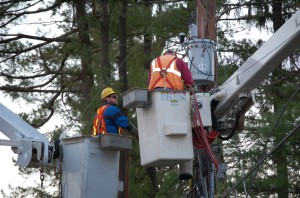
Perhaps a new way to talk about the weather is in dollars and cents. A pair of winter storms within a 12-month span cost Central Hudson $2.1 million, the definition of cold hard cash.
But the region”™s utility customers have been relatively lucky as national images of exploding levees and twister-blasted towns amply attest.
The region has seen some flooding this spring; at times Route 17 had water along both flanks making it look like the road to the Florida Keys. But the Hudson Valley had only to look over its collective shoulder to Little Falls, N.J. ”“ a national headline maker ”“ to know the worst, so far, has missed it. Poughkeepsie received 3.8 inches of precipitation in April, spread across 11 days, nothing unusual in a region that averages 49 inches per year. Farther south, the swarm of 200-plus twisters that killed 340 people and injured 1,700 April 30 represented more tornadoes in a single day than have ever been recorded.
The year 2010 produced a couple of historic blizzards, keeping the region in lockstep with the nation”™s potent weather patterns. Monroe caught 26 inches in December 2010 (the Christmas blizzard) and 31 inches in February 2010. Local reports topped three feet for both storms. After the Christmas blizzard, the winter of 2010-11 featured at least three broad snow events of at least a foot ”“ depending on location there may have been more ”“ followed by a March ice storm. It was, in the words of Central Hudson Energy Group, whose personnel and infrastructure operate in a fishbowl when the weather turns dramatic, “an unusually harsh winter.”
It also impacted the bottom line.

First-quarter earnings for Central Hudson Energy Group, $1.08 per share, were 22 cents lower than the first quarter of 2010.
“Higher expenses associated with restoration of electric and natural gas service during an unusually harsh winter, accelerated tree trimming and a partial disallowance of deferred costs from a prior period had significant impacts on our first-quarter results,” Steven V. Lant, chairman of the board, president and CEO, said in a statement. “Normalized for those unique items, first-quarter earnings per share would have totaled $1.31, an increase of 1 cent per share as compared to the first three months of 2010.”
Specific to the weather, Lant said that $2.1 million in costs associated with the March ice storm and a decision by the state Public Service Commission to disallow the recovery of certain expenses associated with multiple February 2010 snowstorms (the blizzard was only the most dramatic storm) had a 3-cents-per-share one-time, negative impact on the quarter.
Lant also said higher taxes accounted for an 8-cent impact per share and higher depreciation accounted for a 3 percent hit per share.
“These unfavorable variables were somewhat offset by higher delivery revenues of 10 cents per share and higher carrying charges of 3 cents per share,” Lant said.
CH provides energy services to about 57,000 customers.















